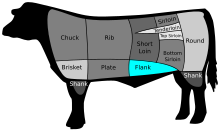 Cuts of beef | |
| Type | cut of beef |
|---|---|
| Part of a series on |
| Steak |
|---|
Flank steak is a cut of beef steak taken from the abdominal muscles of the cow, located just behind the plate and in front of the rear quarter. It is a long, flat cut with a significant grain, and is known for its bold flavor and chewiness.
Terminology[edit]

In Brazil, it is called bife do vazio or pacú (many people confuse with fraldinha, which is actually the flap steak).[1] It is popular in south Brazil, specifically in Rio Grande do Sul state. The cut is also common in Colombia, where they call it sobrebarriga ("over the belly"); sobrebarriga a la brasa is a Colombian recipe for braised flank steak.[2] Argentina, Uruguay call flank steak churrasquito de vacío or bife de vacío. In Spain and Cuba, it is known as filete de falda.
Use[edit]

Flank steak is used in dishes including London broil and as an alternative to the traditional skirt steak in fajitas. It can be grilled, pan-fried, broiled, or braised for increased tenderness. Grain (meat fibre) is noticeable in flank steaks, as it comes from a well-exercised part of the cow, and many chefs cut across the grain to make the meat more tender. It is often used in Asian cuisine, is sold in Chinese markets as "stir-fry beef", and is served in French cuisine as an at-most medium-rare steak. Flank also serves as a common cut for steak jerky.
See also[edit]
References[edit]
- ^ "Qual a diferença entre Fraldinha e Bife do Vazio?". 28 July 2017.
- ^ Miller, Bryan (n.d.). "Sobrebarriga a la Brasa (Flank steak Colombian-style)". The New York Times. Retrieved 6 September 2021.


Well, that’s interesting to know that Psilotum nudum are known as whisk ferns. Psilotum nudum is the commoner species of the two. While the P. flaccidum is a rare species and is found in the tropical islands. Both the species are usually epiphytic in habit and grow upon tree ferns. These species may also be terrestrial and grow in humus or in the crevices of the rocks.
View the detailed Guide of Psilotum nudum: Detailed Study Of Psilotum Nudum (Whisk Fern), Classification, Anatomy, Reproduction